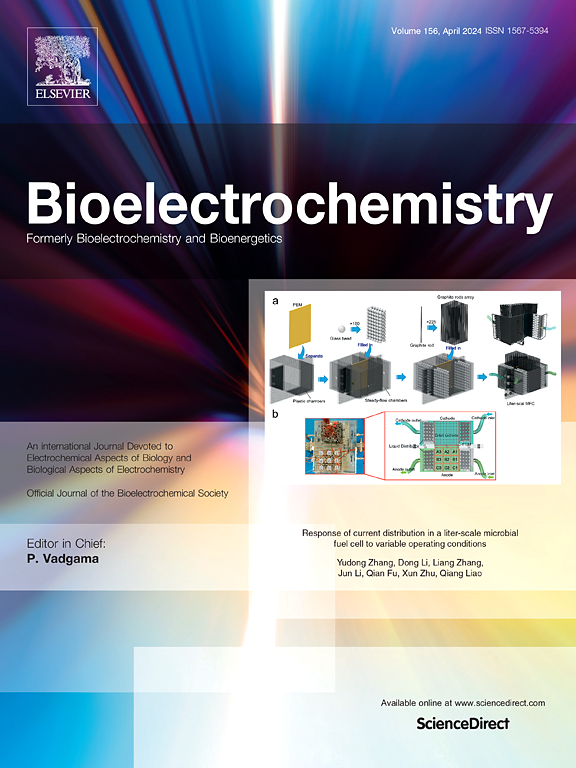Enhanced photocurrent generation of a bio-photocathode based on photosystem I integrated in solvated redox polymers films nanostructured by SWCNTs
IF 4.8
2区 化学
Q1 BIOCHEMISTRY & MOLECULAR BIOLOGY
引用次数: 0
Abstract
The most energetic light-induced charge-separation step in nature is driven by photosystem I (PSI), making this photosynthetic protein an attractive candidate for the development of semi-artificial energy conversion devices. Despite significant progress in semiconductor-free bio-photocathodes, the highest photocurrent density was only 322 ± 19 μA cm−2, achieved by integrating PSI within a pH-dependent poly(vinyl)imidazole Os(bispyridine)2Cl redox polymer (T Kothe et al., Chem. Eur. J., 2014, 20, 11029). This study presents a more efficient PSI-based bio-photocathode by incorporating single-walled carbon nanotubes (SWCNTs) into the redox hydrogel composed of the same Osmium-containing redox polymer. The nanostructured redox hydrogel film with SWCNTs serving as electric scaffolds significantly improves the stability, loading amount, and heterogeneous electron transfer rate, resulting in a substantial increase in photocurrent density exceeding 2 mA cm−2, the highest achieved in a semiconductor-free PSI based photocathode to date. Bioelectrodes constructed by pre-depositing SWCNTs on the electrode surface via covalent bonds outperform those formed by co-immobilizing SWCNTs with the redox hydrogel. The dependence of photocurrent on light intensity and the photocurrent spectrum action demonstrate that the photocurrent unequivocally arises from PSI charge separation. This research lays a promising foundation for the development of semi-artificial photoelectrochemical devices for light-to-energy conversion.

基于光系统I集成在SWCNTs纳米结构的溶剂化氧化还原聚合物薄膜中的生物光电阴极的增强光电流产生
自然界中最具能量的光诱导电荷分离步骤是由光系统I (PSI)驱动的,这使得这种光合蛋白成为开发半人工能量转换装置的有吸引力的候选者。尽管在无半导体生物光电阴极方面取得了重大进展,但通过将PSI集成到ph依赖性聚(乙烯基)咪唑Os(双吡啶)2Cl氧化还原聚合物中,最高光电流密度仅为322±19 μA cm - 2 (T Kothe et al., Chem)。欧元。[J] .地球物理学报,2014,20(1):109 - 109。本研究通过将单壁碳纳米管(SWCNTs)掺入由相同的含锇氧化还原聚合物组成的氧化还原水凝胶中,提出了一种更高效的基于psi的生物光电阴极。以SWCNTs作为电支架的纳米结构氧化还原水凝胶膜显著提高了稳定性、负载量和非均相电子转移率,导致光电流密度大幅增加,超过2 mA cm - 2,这是迄今为止在无半导体PSI基光电阴极中达到的最高水平。通过共价键在电极表面预沉积SWCNTs构建的生物电极优于与氧化还原水凝胶共固定SWCNTs形成的生物电极。光电流对光强的依赖性和光电流谱的作用表明,光电流是由PSI电荷分离产生的。该研究为开发用于光能转换的半人工光电化学器件奠定了良好的基础。
本文章由计算机程序翻译,如有差异,请以英文原文为准。
求助全文
约1分钟内获得全文
求助全文
来源期刊

Bioelectrochemistry
生物-电化学
CiteScore
9.10
自引率
6.00%
发文量
238
审稿时长
38 days
期刊介绍:
An International Journal Devoted to Electrochemical Aspects of Biology and Biological Aspects of Electrochemistry
Bioelectrochemistry is an international journal devoted to electrochemical principles in biology and biological aspects of electrochemistry. It publishes experimental and theoretical papers dealing with the electrochemical aspects of:
• Electrified interfaces (electric double layers, adsorption, electron transfer, protein electrochemistry, basic principles of biosensors, biosensor interfaces and bio-nanosensor design and construction.
• Electric and magnetic field effects (field-dependent processes, field interactions with molecules, intramolecular field effects, sensory systems for electric and magnetic fields, molecular and cellular mechanisms)
• Bioenergetics and signal transduction (energy conversion, photosynthetic and visual membranes)
• Biomembranes and model membranes (thermodynamics and mechanics, membrane transport, electroporation, fusion and insertion)
• Electrochemical applications in medicine and biotechnology (drug delivery and gene transfer to cells and tissues, iontophoresis, skin electroporation, injury and repair).
• Organization and use of arrays in-vitro and in-vivo, including as part of feedback control.
• Electrochemical interrogation of biofilms as generated by microorganisms and tissue reaction associated with medical implants.
 求助内容:
求助内容: 应助结果提醒方式:
应助结果提醒方式:


